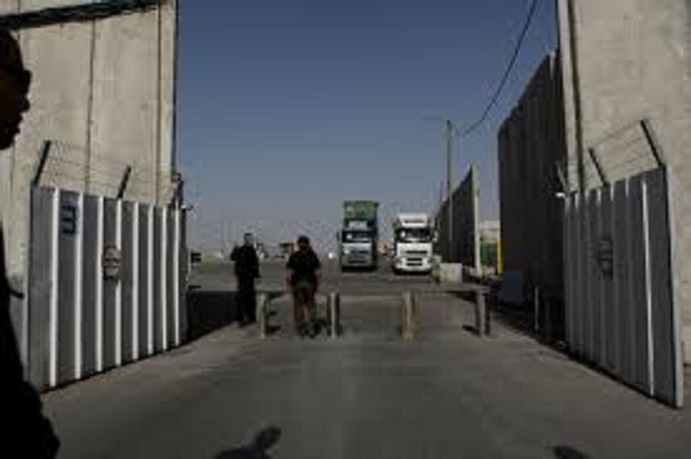Restrictions on the Gaza Strip are part of a sequence going back decades predating Hamas control, analysts say.
Al-Jazeera / June 10, 2019
This summer marks an important but often overlooked anniversary in the history of the Gaza Strip. Thirty years ago, in June 1989, Israel imposed for the first time a magnetic-card system to restrict the exit of Palestinian residents. Anyone denied a card would be prevented from leaving.
While Israel’s blockade of Gaza is often seen to have originated in 2006-2007 as a response to Hamas’s rise to power, the isolation of the enclave in fact goes back three decades – and for many analysts, this historical perspective is essential for understanding today’s developments.
“I think it is incredibly important to look at the wider context to understand what’s going on today in Gaza,” Tania Hary, executive director of Israeli human rights NGO Gisha, told Al-Jazeera.
“Most people mistakenly believe that what’s happening is a result of Hamas being in power, and that while the humanitarian crisis is an ‘unfortunate’ side effect, ultimately Israel has no choice.”
In fact, human rights activists and scholars point out, the Israeli-imposed restrictions on the Gaza Strip are part of a sequence going back decades, predating Hamas control and rocket fire.
“The blockade is not an isolated event in Israel’s policy towards Gaza,” Sara Roy, a senior research scholar at Harvard University’s Centre for Middle Eastern Studies, told Al-Jazeera.
“From the beginning of the occupation in 1967, Israeli policy towards Gaza has been shaped by political considerations that deliberately restricted domestic economic development and structural reform in order to preclude the emergence of a Palestinian state,” she added.
“The blockade can be understood as a part of this policy continuum.”
According to Tareq Baconi, an analyst with International Crisis Group and author of Hamas Contained, “It is impossible not to view this blockade as a continuation of Israeli policies of pacification and isolation that go back to the founding of the state in 1948.”
“Hamas is simply the fig leaf that allows Israel to sustain policies towards Gaza that had long informed its approach towards the strip, primarily driven by demographic reasons and for reasons that have to do with depoliticising the Palestinian struggle,” he continued.
“The current blockade on the Gaza Strip did not begin with Hamas, and if Hamas were to be removed from the equation, it would very likely be the case that Israeli efforts to contain the Gaza Strip would morph into a new form,” Baconi told Al-Jazeera.
‘Big jail’
As early as 1995 – such as in this report by The New York Times – Palestinians were describing conditions in the Gaza Strip as akin to living in a “big jail”.
In 1998, the European Commission was highlighting “draconian restrictions imposed by Israel at all times on entry and exit of both people and merchandise originating in or sent to Gaza”.
The isolation of the Gaza Strip dramatically intensified during the second Intifada, and then again, following Israel’s unilateral removal of settlers (the “disengagement”) in 2005 – a development which, contrary to Israeli claims, did not change Gaza’s status as Israeli-occupied.
“Movement has become the exception, and restriction is the rule,” said Hary, whose NGO works to protect the freedom of movement of Palestinians.
“Whereas it used to be that anyone could travel freely except those who were denied, this has shifted since the late 1980s and early 1990s, so that now no one can travel except those with permits.”
This longer perspective is at odds with an international engagement that tends to be reactive, and shaped by a pattern of periodic escalations between Israel and Palestinian factions.
But Israel justifies the restrictions on movement primarily by citing security concerns.
In November 2018, the Gaza Policy Forum saw dozens of diplomats, aid agencies and experts meet to discuss how best to safeguard the human rights of the enclave’s Palestinian residents.
A document issued after the gathering stated that “Gaza is the most extreme manifestation of a process which has been taking place in the Palestinian territory as a whole since 1993: the process of maintaining control, without having the responsibility that comes with that control”.
Baconi, who attended the event, told Al-Jazeera that he agrees with this assessment. “Israeli policy towards the Palestinians is to sustain Israel’s ability to manage the [occupied] territories, and the broader Palestinian question, with the least responsibility and cost to the Israeli public”.
Roy agrees. “Israel has maintained total control over Gaza without assuming any real responsibility for it,” she told Al-Jazeera. Responsibility, she added, “has long and largely been left to the donor community”.
The fact that the international community has picked up the tab for Israel, rather than apply pressure or seek accountability, worries those who think there are lessons to be learned in Gaza with respect to Israel’s designs in the West Bank.
“I think the example of Gaza should be heeded very, very closely,” Hary told Al-Jazeera, “because I do think this is what could be applied in the West Bank, and to a certain extent it already is, but we could see more extreme versions of it.”
“By failing to demand accountability for Israel’s Gaza policy, the international community is risking making the West Bank population vulnerable to the same level of disregard”.
‘Eliminate Palestinian control’
In the 2016 edition of The Gaza Strip: The Political Economy of De-development, Roy identified “two recurring themes” in her “three decades of research on the Gaza Strip”.
The first is “Israel’s desire to rid itself of any responsibility for Gaza while retaining control of it”. The second theme “centres on Israel’s desire to ‘exchange’ Gaza, as it were, for full and internationally (i.e. American) sanctioned control of the West Bank”.
Overall, she wrote, “the objective was to eliminate Palestinian control over the whole of the West Bank and East Jerusalem and sever most ties between these areas and Gaza”.
Earlier this year, prime ministerial adviser Jonathan Urich told Makor Rishon newspaper that Benjamin Netanyahu had “succeeded in achieving a severance” between Gaza and the West Bank and “effectively smashed the vision of the Palestinian state in those two regions”.
Urich may have been talking in the context of election campaigning, but the status quo in both the Gaza Strip and West Bank – and the international community’s refusal to challenge Israel’s “responsibility without control” paradigm – makes it hard to argue against such a claim.
Ben White is a journalist, analyst and author who has visited and wrote about Palestine for more than a decade.













